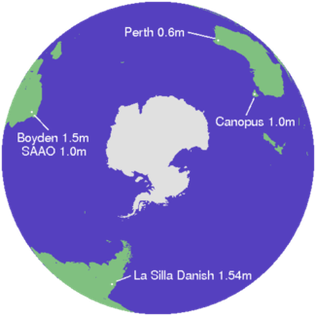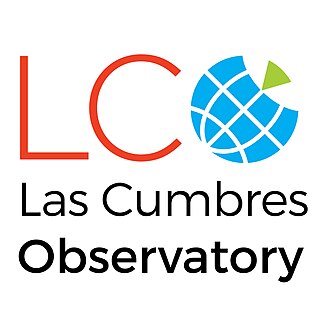
The McDonald Observatory is an astronomical observatory located near the unincorporated community of Fort Davis in Jeff Davis County, Texas, United States. The facility is located on Mount Locke in the Davis Mountains of West Texas, with additional facilities on Mount Fowlkes, approximately 1.3 kilometers (0.81 mi) to the northeast. The observatory is part of the University of Texas at Austin. It is an organized research unit of the College of Natural Sciences.

The Southern African Large Telescope (SALT) is a 10-metre class optical telescope designed mainly for spectroscopy. It consists of 91 hexagonal mirror segments each with a 1-metre inscribed diameter, resulting in a total hexagonal mirror of 11.1 by 9.8 m. It is located close to the town of Sutherland in the semi-desert region of the Karoo, South Africa. It is a facility of the South African Astronomical Observatory, the national optical observatory of South Africa.
Boyden Observatory is an astronomical research observatory and science education centre located in Maselspoort, 20 kilometres (12 mi) north-east of the city of Bloemfontein in Free State, South Africa. The observatory is managed by the Physics Department of the University of the Free State (UFS). The Friends of Boyden assist the observatory as a public support group, organising open evenings and protecting its public interest. Boyden also makes use of members of ASSA Bloemfontein Centre, the amateur astronomy club of the city, for presenters and telescope assistants.

The Cerro Tololo Inter-American Observatory (CTIO) is an astronomical observatory located on Cerro Tololo in the Coquimbo Region of northern Chile, with additional facilities located on Cerro Pachón about 10 kilometres (6.2 mi) to the southeast. It is within the Coquimbo Region and approximately 80 kilometres (50 mi) east of La Serena, where support facilities are located. The site was identified by a team of scientists from Chile and the United States in 1959, and it was selected in 1962. Construction began in 1963 and regular astronomical observations commenced in 1965. Construction of large buildings on Cerro Tololo ended with the completion of the Víctor Blanco Telescope in 1974, but smaller facilities have been built since then. Cerro Pachón is still under development, with two large telescopes inaugurated since 2000, and one in the early stages of construction

The Liverpool Telescope (LT) is a two-metre-aperture robotic Ritchey–Chrétien telescope that observes autonomously. However professional astronomers, school groups and other credible registered users submit specifications to be considered by its robotic control system (RCS) at any time using an online graphical user interface. Each night the RCS decides among these choices, and among any notified or glimpsed transient events, what to observe, based on target visibility and weather conditions.

A robotic telescope is an astronomical telescope and detector system that makes observations without the intervention of a human. In astronomical disciplines, a telescope qualifies as robotic if it makes those observations without being operated by a human, even if a human has to initiate the observations at the beginning of the night, or end them in the morning. It may have software agents using Artificial Intelligence that assist in various ways such as automatic scheduling. A robotic telescope is distinct from a remote telescope, though an instrument can be both robotic and remote.

Siding Spring Observatory near Coonabarabran, New South Wales, Australia, part of the Research School of Astronomy & Astrophysics (RSAA) at the Australian National University (ANU), incorporates the Anglo-Australian Telescope along with a collection of other telescopes owned by the Australian National University, the University of New South Wales, and other institutions. The observatory is situated 1,165 metres (3,822 ft) above sea level in the Warrumbungle National Park on Mount Woorat, also known as Siding Spring Mountain. Siding Spring Observatory is owned by the Australian National University (ANU) and is part of the Mount Stromlo and Siding Spring Observatories research school.

The Indian Astronomical Observatory (IAO), located in Hanle near Leh in Ladakh, India, has one of the world's highest located sites for optical, infrared and gamma-ray telescopes. It is operated by the Indian Institute of Astrophysics, Bangalore. It is currently the tenth highest optical telescope in the world, situated at an elevation of 4,500 meters (14,764 ft).

Teide Observatory, IAU code 954, is an astronomical observatory on Mount Teide at 2,390 metres (7,840 ft), located on Tenerife, Spain. It has been operated by the Instituto de Astrofísica de Canarias since its inauguration in 1964. It became one of the first major international observatories, attracting telescopes from different countries around the world because of the good astronomical seeing conditions. Later the emphasis for optical telescopes shifted more towards Roque de los Muchachos Observatory on La Palma.

South African Astronomical Observatory (SAAO) is the national centre for optical and infrared astronomy in South Africa. It was established in 1972. The observatory is run by the National Research Foundation of South Africa. The facility's function is to conduct research in astronomy and astrophysics. The primary telescopes are located in Sutherland, which is 370 kilometres (230 mi) from Observatory, Cape Town, where the headquarters is located.

The Fabra Observatory is an astronomical observatory located in Barcelona, Catalonia, Spain pointed towards the south at 415 metres above sea level.

Hamburg Observatory is an astronomical observatory located in the Bergedorf borough of the city of Hamburg in northern Germany. It is owned and operated by the University of Hamburg, Germany since 1968, although it was founded in 1825 by the City of Hamburg and moved to its present location in 1912. It has operated telescopes at Bergedorf, at two previous locations in Hamburg, at other observatories around the world, and it has also supported space missions.

Mount Lemmon Observatory (MLO), also known as the Mount Lemmon Infrared Observatory, is an astronomical observatory located on Mount Lemmon in the Santa Catalina Mountains approximately 28 kilometers (17 mi) northeast of Tucson, Arizona (US). The site in the Coronado National Forest is used with special permission from the U.S. Forest Service by the University of Arizona's Steward Observatory, and contains a number of independently managed telescopes.

The Probing Lensing Anomalies NETwork (PLANET) collaboration coordinates a network of telescopes to rapidly sample photometric measurements of the magnification of stars in the galactic bulge undergoing gravitational microlensing by intervening foreground stars. This network consists of five 1m-class optical telescopes distributed in longitude around the southern hemisphere in order to perform quasi-continuous round-the-clock precision monitoring. On a target-of-opportunity basis, less frequent spectroscopic measurements complement the rapid photometry for selected prime targets. Since 2005, PLANET performs a common microlensing campaign with RoboNet-1.0, a network of UK-operated 2.0m robotic telescopes.

Las Cumbres Observatory (LCO) is a network of astronomical observatories run by a non-profit private operating foundation directed by the technologist Wayne Rosing. Its offices are in Goleta, California. The telescopes are located at both northern and southern hemisphere sites distributed in longitude around the Earth. For some astronomical objects, the longitudinal spacing of telescopes allows continuous observations over 24 hours or longer. The operating network currently consists of two 2 meter telescopes, nine 1 meter telescopes, and seven 40 cm telescopes, placed at six astronomical observatories. The network operates as a single, integrated, observing facility, using a software scheduler that continuously optimizes the planned observing schedule of each individual telescope.

Leibniz Institute for Astrophysics Potsdam (AIP) is a German research institute. It is the successor of the Berlin Observatory founded in 1700 and of the Astrophysical Observatory Potsdam (AOP) founded in 1874. The latter was the world's first observatory to emphasize explicitly the research area of astrophysics. The AIP was founded in 1992, in a re-structuring following the German reunification.
Kunlun Station is the southernmost of four Chinese research stations in Antarctica. When it is occupied during the summer, it is the second-southernmost research base in Antarctica, behind only the American Amundsen–Scott South Pole Station at the geographical South Pole. When Kunlun is not in operation, the year-round Russian Vostok Station is the second-southernmost base in Antarctica.

Merate Astronomical Observatory is an old observatory in Merate (Lecco), Italy. It has housed a 1-meter Zeiss telescope since 1926.

Cerro Armazones Observatory was an astronomical observatory owned and operated jointly by the Ruhr University Bochum (RUB) and the Catholic University of the North (UCN). It was established in 1995 on the slopes of Cerro Armazones, a mountain in the Antofagasta Region of Chile. The observatory is located in the Atacama Desert about 110 kilometres (68 mi) south of the city of Antofagasta. Unlike many other observatories, OCA is not located at the highest point of its host mountain. Instead, it was in a saddle approximately 340 metres (1,120 ft) below the summit and 1 kilometre (0.62 mi) to the southwest. This location has been given up due to the vicinity of the ELT construction site in January 2014. The Telescopes of the Bochum university, installed after 2006, are no longer operational. They are located 500 metres (1,600 ft) further to the west and 100 metres (330 ft) higher than the original OCA observatory, on a subsidiary peak of Cerro Armazones, Cerro Murphy. The coordinates here are those of this summit now.
The Kilodegree Extremely Little Telescope is an astronomical observation system formed by two robotic telescopes that are conducting a survey for transiting exoplanets around bright stars. The project is jointly administered by members of Ohio State University Department of Astronomy, the Vanderbilt University Department of Physics and Astronomy Astronomy Group, the Lehigh University Department of Physics, and the South African Astronomical Observatory (SAAO).
















